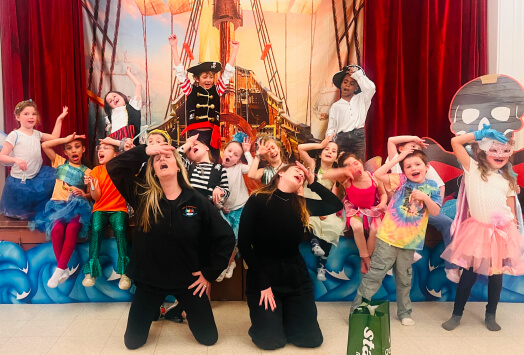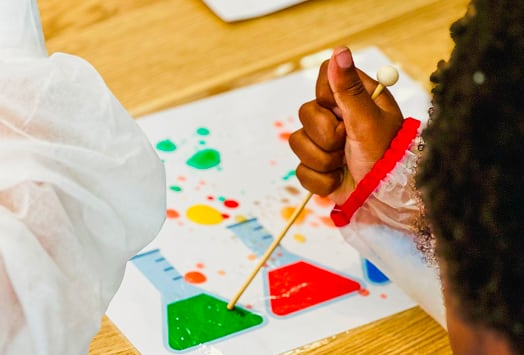Running an after school program requires a lot of planning and organization. Not only do you need to do all of the administrative work, like finding and setting up a space, running marketing campaigns to get customers, and managing communication with families, but also you need to write a curriculum, create lesson plans, and actually run your classes!
At Sawyer, our goal is to help children’s activity business owners spend less time on the administrative work and more time doing what they love. In this guide, we will outline after school program ideas and activities that you can implement in your sessions. We also have an editable after school program lesson plan template that you can adapt for your own use.
- After school program ideas
- After school program lesson plans
- After school program activities
- ~After school art activities
- ~After school STEM activities
- ~After school sports activities
- ~After school dance activities
After school program ideas
Ready to take the leap and start an after school program? The first step is to decide what type of program you are going to run.
Start by asking yourself these questions:
- Will your after school program be focused around a certain topic, like art or STEM, or will you do a mix of everything?
- Are you planning to offer programming every day of the week or just once or twice a week? Typically, programs that run every day after school are more general and include time for homework as well.
- What ages will you accept in your program? If you are just starting out, it might be easier to start with a small range of ages and then work your way up to accepting more.

After school program lesson plans
Once you have a better sense of the type of after school program you want to run, you can start thinking about the activities you will do with your students. We recommend writing an after school program curriculum as an outline and then diving deeper into each lesson plan and activities.
Even though you will likely not use grades or formal assessments during your after school program, writing a lesson plan is still extremely important. Lesson plans keep instructors on track and make it easier for children to learn.
Your lesson plan should consist of a few main elements. Read why each one is important, then use our editable after school program lesson plan template to create your own lesson plans.
Lesson plan format
1. Objective(s)
It is important to start with the objective(s) because they are the guiding principles behind your entire lesson. What is the goal? What do you want the students to be able to do or know at the end of the session? Be action-oriented and measurable so you can keep yourself accountable.
Lesson objective examples
- Learn the first 30 seconds of a choreographed dance.
- Explore landscape art and create a project to take home.
- Learn about electricity and create a potato circuit.
2. Materials
Make a list of the materials, supplies, and equipment you will need for this lesson. Then, don’t forget to bring them! Not sure where to buy supplies? Check out our guide.
3. Activities & timing
What will you actually be doing to accomplish the objective set at the beginning of your lesson plan? Walk through your plans step-by-step so you can stay on track. We recommend writing out each activity and including a time estimate with each one so that you can map out the session.
You should be planning a variety of activities for each lesson. Children learn more easily when they are engaged in interactive experiences like playing games, which can enhance classroom learning. You can also consider adding in some Montessori techniques so children can have more agency in the activities.
Here are some examples of lesson activities:
- With a partner, come up with a 10 second dance that incorporates 3 different movement styles to warm up your bodies and your minds.
- Take 5 minutes to write about your favorite art medium and then discuss in groups.
- Read about what goes into a circuit. Try to draw an unusual circuit on your own, then discuss your findings with a partner
4. Assessment & evaluation
In this case, your assessment will likely be less formal than in a school classroom setting. However, it is still helpful for instructors to see what the students learned from the lesson. This helps them determine where to start on the next lesson. Plus, they can also get a sense of which activities worked well and which ones didn’t, so they can adjust for their next lesson. You can also take notes during the lesson if there are places where a lot of students are stuck or if there are activities many students are enjoying.
Use our editable after school lesson plan template for your next session!
Get our editable after school program lesson plan template
After school program activities
Now that you know how to write a lesson plan, it’s time to think about the activities that will fill your lessons! We’ll outline some of our favorite after school activities for different subject and you can pick and choose what works for your students.
After school art activities
Art helps children express their emotions, develop their creativity, and improve their motor skills. When children participate in art after school activities, they get the chance to fully explore without worrying about grades and assessments. Here are some of our favorite art activities that your students can try.
- Create art from nature. Let the students explore outside to find materials that they can use for their art. Pine needles, sand, pebbles, and leaves all make great additions to future masterpieces.
- Paint a song. Put on music and ask your students to paint how the song makes them feel. Your students can flex their creative muscles and think as freely as they want.
If you are looking for guidance when teaching art to children, review our full guide.
After school STEM activities
STEM stands for science, technology, engineering, and math. STEM activities are great for students to learn about and explore the world around them. Try these activities for your next STEM lessons.
- Fossil search. Explore the grounds to find different types of rocks and “fossils”, then bring them back and catalog them.
- Egg drop. Challenge students to create a container that will protect an egg when it falls. Then test the container’s efficiency by dropping it from different heights.
Looking for more STEM fun? We’ve outlined some of our favorite science lessons, experiments, and projects for kids in our article.

After school sports activities
After sitting in school all day, sports, movement, and exercise make for great after school activities. Try these after school sports and movement activities to help your students their energy out.
- Passing by number. This is a fun game for soccer, basketball, football, field hockey, or baseball/softball. In this drill, each player is given a number. Then, they move around the field/court and pass to the next number in order. It’s a fun drill for kids because they have to focus on their brain and body at the same time.
- Tag. Get your students up and moving with a good old fashioned game of tag. Tag helps children practice making quick starts and stops as well as keeping their eye on their surroundings. It can be a good warm up for soccer, basketball, field hockey, tennis, and really any sport.
Check out our guide to learn how to teach soccer to kids, which includes great soccer drills and games you can play on the field.
After school dance activities
Dance helps children with balance, confidence, and coordination. They get to work as a team and individually. Check out some of our favorite after school dance activities for your programming.
- Dance to a story. Ask your students to create dance moves or dance routines to act out a story you tell or one that they choose. Fairytales and popular children’s books are great options.
- Simon says. This is a great learn to dance game because children use imitation as one of their main ways of learning. In this game, stand in the front of the room and have them copy the dance poses that you do, as long as you say “Simon says.” If you don’t say it, they should remain still. When children get out, have them practice their favorite pose.
Use our guide with helpful tips and more activities for teaching kids to dance.
If you are ready to start an after school program for kids and run it successfully, the team at Sawyer is here to support you! We have the best class registration and management software, which helps hundreds of after school programs across the country save time on admin so they can spend more time changing the lives of their students.
With our suite of tools, like custom forms to record allergies and t-shirt sizes, flexible payment options like gift cards and installment plans, and seamless scheduling and registration on any device, Sawyer saves business owners 28 hours per month. If you are ready to spend less time on admin and more time doing more of what you love, see how Sawyer can help with a free trial or demo.





















.png)












.avif)
.avif)
.avif)
.avif)




